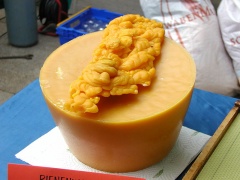Beeswax
| Infobox on Beeswax | |
|---|---|
| Example of Beeswax |  |
| Facts | |
| Origin | - |
| Stowage factor (in m3/t) |
|
| Humidity / moisture | - |
| Ventilation | - |
| Risk factors | Stow away from heat. |
Beeswax
Contents
Description
The wax is formed by worker bees, who secrete it from eight wax-producing mirror glands on the inner sides of the sternites (the ventral shield or plate of each segment of the body) on abdominal segments 4 to 7. The sizes of these wax glands depend on the age of the worker and after daily flights begin these glands gradually atrophy. The new wax scales are initially glass-clear and colorless, becoming opaque after mastication by the worker bee. The wax of honeycomb is nearly white, but becomes progressively more yellow or brown by incorporation of pollen oils and propolis. The wax scales are about 3 millimeters (0.12 in) across and 0.1 millimeters (0.0039 in) thick, and about 1100 are required to make a gram of wax.
Honey bees use the beeswax to build honeycomb cells in which their young are raised and honey and pollen are stored. For the wax-making bees to secrete wax, the ambient temperature in the hive has to be 33 to 36°C (91 to 9 °F). To produce their wax, bees must consume about eight times as much honey by mass. It is estimated that bees collectively fly 150,000 miles, roughly six times around the earth, to yield one pound of beeswax (530,000 km/kg).
When beekeepers extract the honey, they cut off the wax caps from each honeycomb cell with an uncapping knife or machine. Its color varies from nearly white to brownish, but most often a shade of yellow, depending on purity and the type of flowers gathered by the bees. Wax from the brood comb of the honey bee hive tends to be darker than wax from the honeycomb. Impurities accumulate more quickly in the brood comb. Due to the impurities, the wax has to be rendered before further use. The leftovers are called slumgum.
The wax may further be clarified by heating in water. As with petroleum waxes, it may be softened by dilution with vegetable oil to make it more workable at room temperature.
Good quality beeswax has a colour between light yellow and light brown.
Beeswax has a high melting point range of 62 to 64°C (144 to 147°F). If beeswax is heated above 85°C (185°F) discoloration occurs. The flash point of beeswax is 204.4°C (399.9°F).
Density at 15 °C is 958 to 970 kg/m3.











